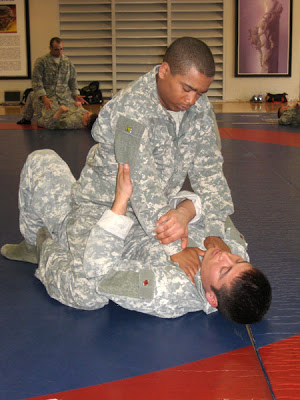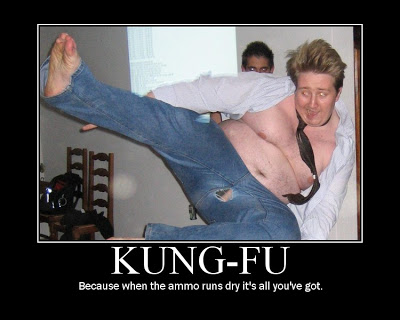
From Strategy Page we have this.
Street Fighting Men
May 5, 2009: Increasingly, the U.S. military is emphasizing street fighting as a neccessary combat technique. The U.S. Army and Marines even hold competitions, where troops can determine who is the best practitioner of "combatives" (as the military likes to call this amalgam of martial arts and brawling.)
Even the U.S. Air Force, after some 20,000 of its airmen served in Iraq, and were exposed to ground combat, decided to upgrade the combat training all airmen get.
While the air force has its own force of security troops, who receive infantry training, Iraq demonstrated that the war could come to everyone. Not since Vietnam, have air force ground operations faced the threat of ground attack. While most air force warplanes operate from nearby nations, and not in Iraq itself, there are still plenty of airfields in Iraq and Afghanistan that have to be defended, and are always subject to terrorist attack. Such attacks have been rare, largely because the air force has, like the army, put a lot of effort into defending those bases.
Starting last year, in addition to more training with assault rifles and pistols, all airmen began taking a course in hand-to-hand combat. The Air Force Combatives program is a 20 hour version of the 40 hour U.S. Army Combatives Program. It basically teaches you the best moves to make if you are ever in a hand-to-hand combat situation. Airmen are encouraged to take additional training, after they have completed the mandatory 20 hours of instruction. Those who have served in Iraq, and especially those who came back with a combat badge, don't need much encouragement.
The army began its Combatives program seven years ago, and it proved so popular that it evolved into a competitive sport. Two years ago, the marines began requiring that everyone qualify for the lowest level belt (tan) of the martial arts program it began in 2001. That goal has proved more difficult than anticipated, but has got marines more focused on hand-to-hand combat.
The marine martial arts effort is also a program of well, street fighting. The Martial Arts Training Program is taught like most other martial arts, allowing for degrees of proficiency, and colored belts to indicate how far a marine has gone from tan (the lowest level) to grey, green, brown and black (the highest.) The marine program is notable for elements that accurately represent actual combat conditions.
For example, before doing the actual combat fighting, trainers wear the marines out with vigorous physical exercise. In combat you are likely to encounter the enemy face to face only after a lot of running around. Another realism element is the random introduction into the training area of items that could be used as weapons (a knife, pipe, piece of lumber). These realism touches make the Marine Corps Martial Arts Training Program popular and effective.
The fighting in Iraq and Afghanistan has reinforced the importance of this program. So all marine infantry had to achieve the green belt by the end of 2008. All combat support marines have to get the grey belt by early 2009. The first (tan) belt only requires about 28 hours of training, but the others need more (from 47 to 72 hours for each level). And, you have to be in very good shape to even get started on the tan belt. But the skills obtained have proved to be lifesavers, especially in raids and search operations, where a nearby civilian often turns into an armed hostile on very short notice.
More on the U.S. Army Combatives School at Wikipedia here, which will introduce you to SFC Matt Larsen's contribution to modern combatives.
More can be found at his own website here, including this:
Welcome to the official web site of Modern Combatives, started in 2002 as a way to promote the efforts, training methods and techniques of the Modern Army Combatives Program as created by Matt Larsen. The goal of Modern Combatives is to build real combative ability by teaching realistic training methods and growing self sustaining indigenous Combatives programs within units and organizations.
There are a couple of basic tenants of Modern Combatives that are important to understand. The first one is that the winner of the hand-to-hand fight in combat is the one whose buddy shows up first with a gun. This is important thing to remember because it puts combative training in perspective. If you drop an enemy dead at your feet with the Vulcan death touch, and his buddy comes in with a gun, you still lose.
As Rex Applegate said in his book Kill or get Killed “Unarmed combat is just what the name implies- a system of fighting intended for use when weapons are not available or when their use is not advisable” Where then does combatives training fit?It must be an integral part of the close quarters fight. Too often “hand-to-hand” is treated as if it were a side note to the actual training. When your weapon malfunctions three feet from the bad guy is no time to start integrating your techniques. Noted Firearms instructor and author Massad Ayoob said it best, “At close range it’s not a shooting contest; it’s a fight.”
With that in mind, the second tenant is that the defining characteristic of a warrior is the willingness to close with the enemy. We do not win wars because we are better at hand-to-hand combat than the enemy, we do however win wars because of the things it takes to be a good hand-to-hand fighter. Any training plan that does not serve to build this fundamental aggressiveness is actually counter productive.
Confidence comes from competence. It is not enough to simply tell soldiers to be aggressive; they must have a faith in their abilities built through hard and arduous training and know that they are going to win; so that when that weapon does malfunction three feet from the bad guy, they will instinctively attack.
And in a brilliant example of great minds thinking alike, Live Free or Die sent me this from the lower end of the combatives spectrum via email just as I was preparing this piece. I doubt this is one of Matt Larsen's students, however.

3 comments:
More tools for the toolbox. Looking into some more edged weapon training right now.
BTW Mike, that pic is almost the last thing I'll see before I go back to bed. Thanks -s-.
Definitely more tools for the tool box....one needs a good knife and a good hawk...and the basic skills and willingness to employ them.
"The Deadliest Warrior" TV show tests different weapons from different ages and pits warriors against each other in computer simulations of battles that never were. In "Apache vs. Gladiator," on a synthetic skull, a stone war club shattered it to cracker crumbs. On a ballistic gelatin head with skull, a steel tomahawk opened up the brain pan like a bowl.
Tactical AND quiet.
Post a Comment